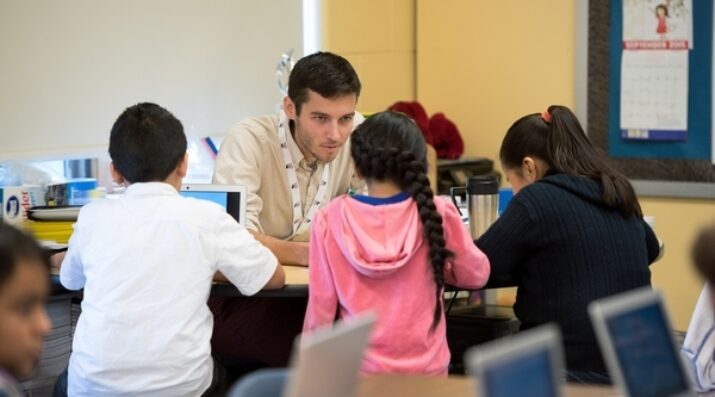New Designs for School
What New Research Can Teach Schools Looking to Put Personalized Learning into Practice
Topics

We’ve all had the experience of truly purposeful, authentic learning and know how valuable it is. Educators are taking the best of what we know about learning, student support, effective instruction, and interpersonal skill-building to completely reimagine schools so that students experience that kind of purposeful learning all day, every day.
A Wisconsin Evaluation Collaborative study of personalized learning in Chicago unpacks how schools can successfully implement personalized learning, highlighting four common practices.
On any given day, a quick glance at newspaper headlines will tell you that the world of work is changing rapidly. The advent of artificial intelligence and automation is completely transforming our economy—and schools need to catch up to give all students opportunities to thrive with these changes. But a closer look, particularly in places like my adopted hometown of Chicago, reveals that a transformation in schools is already afoot. Thousands of trailblazing educators have embraced a way of teaching and learning, called personalized learning, that is helping students develop the independence, curiosity, and critical-thinking skills that are fundamental to success in this ever-changing world.
Through my work at LEAP Innovations, I have the privilege of serving educators who create personalized-learning environments that equitably excite and inspire students with rigorous, student-centered experiences. These educators are connecting academic learning to personal contexts and passions, at a pace that leverages students' strengths and opportunities for accelerated growth. Recognizing its transformative potential, schools, districts, and even entire states are embracing personalized learning. But many administrators and educators are trying to unlock tangible ways to bring it to life in their classrooms.
As a former high school science teacher, I can relate to the frustration of wanting to try new, promising practices in my classroom but not knowing where to start. This is why I'm excited about new research, made possible by the Joyce Foundation, that unpacks how schools can successfully implement personalized learning.
In this study, researchers from the Wisconsin Evaluation Cooperative, located in the Wisconsin Center for Education Research at UW-Madison's School of Education, analyzed the early personalized-learning journeys of six schools in Chicago. Within the city, the largest national urban demonstration site for personalized learning, more than 140 schools and 2,400 educators have partnered with LEAP to pioneer this shift.
These six schools are among the beneficiaries of a 2014 philanthropic initiative by Next Generation Learning Challenges which established Breakthrough Schools, a network of schools committed to testing and surfacing school models that accelerate student achievement. LEAP Innovations and the six Chicago Breakthrough Schools—which included a mix of elementary and secondary schools across the city, reflecting the rich diversity of Chicago's neighborhoods—all received additional support from The Chicago Public Education Fund, Bill & Melinda Gates Foundation, The Joyce Foundation and Northern Trust to advance their work to personalize learning. These schools, dedicated to the whole-school implementation of personalized learning, spent a year working with LEAP Innovations to intentionally design their approach before beginning the shift.
This new research found that when implemented with fidelity to their plans, the Breakthrough Schools' efforts spurred promising early outcomes. Students in personalized classrooms made positive academic gains—and the growth was most notably pronounced among elementary students. Students who started the year at low attainment improved, and students who started at high attainment maintained their levels, showing that personalized learning lifts up students who most need support while also supporting the progress of high-flyers. But perhaps the most critical contributions to the field are the researchers' qualitative findings around implementation.
Researchers identified four common factors in successful implementations: adequate and intentional planning time, schoolwide buy-in, reliable funding, and thoughtful integration of digital tools.
I invite you to read the full report to see this work in action, but here are four quick lessons for educators ready to embrace personalized learning in their own schools:
Invest in Time
The researchers observed that time for intentional planning and collaboration among educators made all the difference. Schools credited the yearlong planning and design process they undertook as critical to their transformation. During that planning period, schools should define their "why" for implementing personalized learning, identify what challenges they may face along the way, and design a set of practices that meet specific needs. But the need for time doesn't stop when implementation starts; once personalized learning is in motion, teachers benefit from designated time outside of the classroom to collaboratively plan, implement, and reflect together on each classroom's successes and challenges.
Involve Everyone
A schoolwide understanding of personalized learning was the foundation for strong implementation in the schools studied. Schools were able to most successfully implement when everyone—educators, students, administrators—in the building could articulate what personalized learning means and how they could further its goals. When schools align the full community around the central vision of their transformation, they create a productive environment for teachers to iterate on new practices, accept constructive feedback, and collaborate with peers to develop a more robust implementation.
Spend Wisely
Schools were most successful when administrators prioritized funding for personalization. While the upfront costs of implementation are relatively low, we found that schools that made transformation a guiding priority in their budgets were most successful. In particular, funding for substitute teachers to create time for teacher professional development, classroom supplies for teachers working to facilitate project-based learning, and personalized-learning coaches to guide teachers through the implementation process, are key elements of a program's success.
Train for Tech
Lastly, strong implementation of digital tools helped teachers differentiate content for learners at different levels and eased teachers' administrative workloads, freeing up time for more in-depth planning and collaboration with students. However, teachers need thorough training on all new tools—including tools that interface with students and tools that are used for behind-the-scenes management—to make the most of new technology. Any new tools should be carefully integrated with existing curriculum and tools.
Zeroing in on these schools' transformation journeys, the researchers called out a few particularly inspired ideas for bringing personalized learning to life. One standout practice was a "genius hour," in which kids were given time to work on projects they love. Another school made use of "flex Fridays," giving learners the freedom to focus on what they want and need every Friday, and "colloquia," in which high school students take on community-based projects.
Every school's existing infrastructure, culture, goals, and needs are different, which means that their pathways to personalization will inevitably diverge at some point. But the early lessons learned from these six schools confirm that successful implementation marries clear and actionable guidance with enough flexibility for educators to iterate on their approach. It is organized around a central end-vision and works with every stakeholder—including administrators, teachers, students—to create a set of practices that serve the school's unique needs.
This study affirms that personalized-learning implementation is not simple—it's hard work. But the payoff is real. Strong implementation invigorates teachers and empowers students, preparing them to take on the world as confident, independent thinkers.
Photo at top courtesy of NGLC: Small group instruction at Cesar E. Chávez Multicultural Academic Center, a K-8 school in Chicago Public Schools and Breakthrough Schools: Chicago grant recipient.




